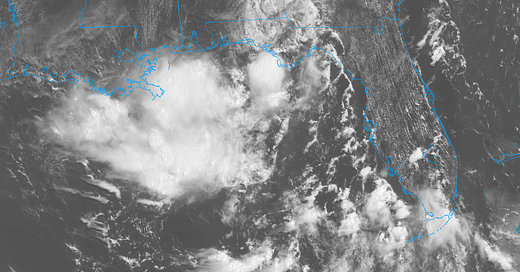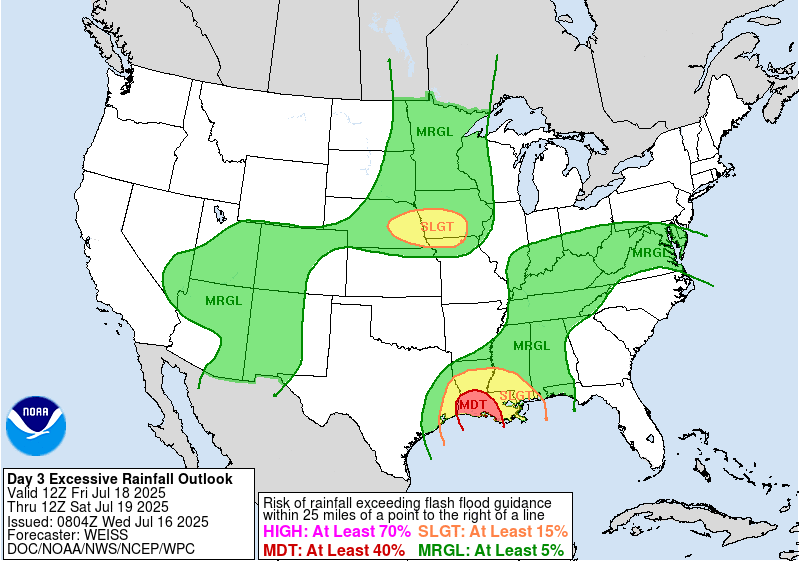Positive signs from Congress on science, not so much from the administration
93L stays disorganized but still a significant heavy rain risk
Happy hump day! There have been some developments related to the weather science community in the last couple of days that I want to start off with today. Yesterday, the House Appropriations subcommittee responsible for the Commerce, Justice and Science (CJS) FY2026 appropriations bill held their “markup” meeting to finalize their version of the bill to be sent to the full Appropriations Committee. As part of this process, they released their draft version of the bill, which contains the high level appropriations for the agencies covered under the bill, which includes NOAA, NASA and the National Science Foundation (NSF).
Overall, the proposed FY26 funding levels are much more robust than what was proposed in the President’s budget, but not as favorable as what appears to be in the Senate version of the bill. NOAA is particularly more favorable, with only a 6% cut compared to the proposed nearly 40% cut by the administration. NASA’s overall proposed budget is flat, but the subcommittee bill does reduce the science portion of the budget by about 18% to $6B. This funding level is still far above the President’s proposed level of $3.9B. Meanwhile, NSF is the hardest hit in the House subcommittee version, with a proposed 23% cut - but still better than the President’s proposed 55% cut.
At this point, we only have the draft of the actual appropriations bill, which would set the funding amounts for the high level agency accounts. Once the bill is approved by the full Appropriations Committee, we should get the proposed “bill report” which will give much more detail on the committee’s intent and more context on the Congressional reaction to some of the detailed plans outlined in NOAA’s “blue book” budget document such as the elimination of the Office of Oceanic and Atmospheric Research (OAR) and NOAA Sea Grant. Undoubtedly, though, what we can see to this point is encouraging with regard to Congressional intent, and implies significant pushback on some of the more draconian cuts being proposed by the administration.
To me, what people concerned about proposed cuts and damage to federal science should be most focused on right now are the actions that the Trump Administration can take unilaterally outside of Congressional oversight. Just today, the Washington Post ran an article outlining how Commerce Secretary Howard Lutnick has stopped NOAA work on developing the NOAA Atlas 15 precipitation frequency atlas. This is a critical project to provide users such as engineers and community planners with updated precipitation frequency estimates for use in designing critical infrastructure to account for increasingly intense rainfall rates. Critically as the NWS Office of Water Prediction describes, “NOAA Atlas 15 represents a shift from a stationary assumption (i.e., extreme precipitation events do not change significantly over time) to a nonstationary assumption (i.e., extreme precipitation events change over time), a key modification that may impact the manner in which precipitation frequency information is applied.”
Obviously, though, given what I have discussed just in the last few days about the role of climate change in more frequent, intense rainfall events, the Atlas 15 project will show clear climate change impacts, and that appears to be why it is being targeted by the administration. This project was also funded by the Biden-era Bipartisan Infrastructure Law (BIL), and many BIL projects have also been targeted by the administration. The loss of this project would have a huge negative impact on society’s ability to adequately prepare for and mitigate the impacts of climate change.
Another story that has been breaking in the last 24 hours relates to NOAA Weather Radio. There has been social media traffic about letters going out from NOAA contracting officers terminating NOAA Weather Radio (NWR) maintenance contracts. This morning, Senator Ed Markey (D-MA) tweeted that these letters are in fact being sent to PBS stations that have NOAA Weather Radio related contracts, and are in fact being terminated due to the administration’s opposition to PBS.
To give you some background, when I was the meteorologist-in-charge of the Jackson, MS office, most of our NWR sites in Mississippi were located at the broadcast towers of the statewide public broadcasting system, Mississippi Public Broadcasting (MPB). Tower space for broadcast antennas can be hard to come by and expensive, and in a number of states there is a collaborative relationship between NOAA/NWS and local public broadcasting to support NOAA Weather Radio and for public broadcasters to host NWR equipment. At one time in Mississippi NOAA also contracted with MPB to perform the actual maintenance on the equipment, although that was terminated while I was still there and I am unsure as to if those sorts of arrangements are still in place in other parts of the country. Regardless, if what Sen. Markey is describing is in fact what is happening, I would think this is a serious concern for the NWR program as it could require NOAA to try to find new tower space for a number of NOAA Weather Radio sites, which I expect would be a very daunting task for local and regional NWS offices already under a lot of strain for other reasons (mostly relating to other administration activity).
These are some examples of actions the administration can take - but even more concerning is the fact that this administration has made it clear that they believe they can undertake reorganization and budget actions based on their own executive branch plans regardless of Congressional action or intent. In the last week, Supreme Court rulings have given the administration approval for this type of action, green-lighting reorganization and staff reductions at the State Department and administration plans to close the Department of Education.
How aggressive the Trump Administration will be in its similar reorganization plans for NOAA including elimination of OAR and NOAA Sea Grant remain to be seen. However, I want to emphasize that until a new FY26 budget is approved by both houses of Congress and signed by the President, the administration is operating under the FY25 budget act (or under a continuing resolution after October 1). As was reported with the passage of the FY25 budget, the administration has much more unilateral control than is typical over their execution of the FY25 budget given how that budget act was structured. The FY26 Congressional budget process is still in its relatively early stages, and in recent years, new budgets have not been fully in place until after the 1st of the calendar year. This would mean the administration has several more months to pursue their specific goals and plans before receiving clear guidance from Congress. One would hope that given the signs we have seen so far from Congress pushing back on the administration plans that Congress will be very clear in their budget activities on their priorities and intent for federal science.
Turning now to the weather, today will see plenty of thunderstorm activity over much of the country. Several areas will have more focused risks for flash flooding and severe weather as shown above, but as of now, no area has higher than a slight risk for either hazard.
With regard to tropical disturbance 93L that we have been following, it remains disorganized with the main center of circulation that we have been tracking still over land over the Florida panhandle, which will reduce the risk of any organized development. The system is producing widespread strong thunderstorm activity across the northern Gulf however, and it is certainly possible that a new circulation center could develop associated within one of those clusters of storms. As of now, NHC has held their probability of tropical cyclone development at 40%, but certainly the risk of any sort of a significant tropical storm (or even stronger system) seems to be mainly off the table at this point.
Given the trend toward a less organized system, the probability for a higher end scenario for heavy rain and flash flooding has also come down. Still, heavy rainfall and flash flooding will be a significant risk along the Gulf Coast with the system, with WPC showing the risk peaking on Friday with a moderate risk for parts of southern Louisiana.
Heat advisories continue in parts of the south central and eastern US as very high humidity combines with above normal temperatures to exacerbate heat stress. Red flag warnings are in effect for parts of Washington state as wildfires continue to be a growing concern in the western states and Alaska, with the National Interagency Fire Center reporting 10 new large fires in the last 24 hours.







To say that I am infuriated by this administration's attack on science based solely on ideology, is a massive understatement. I personally resent their attempt to return America to a dark ages approach to science. The sooner these mutts are ousted from power the better.